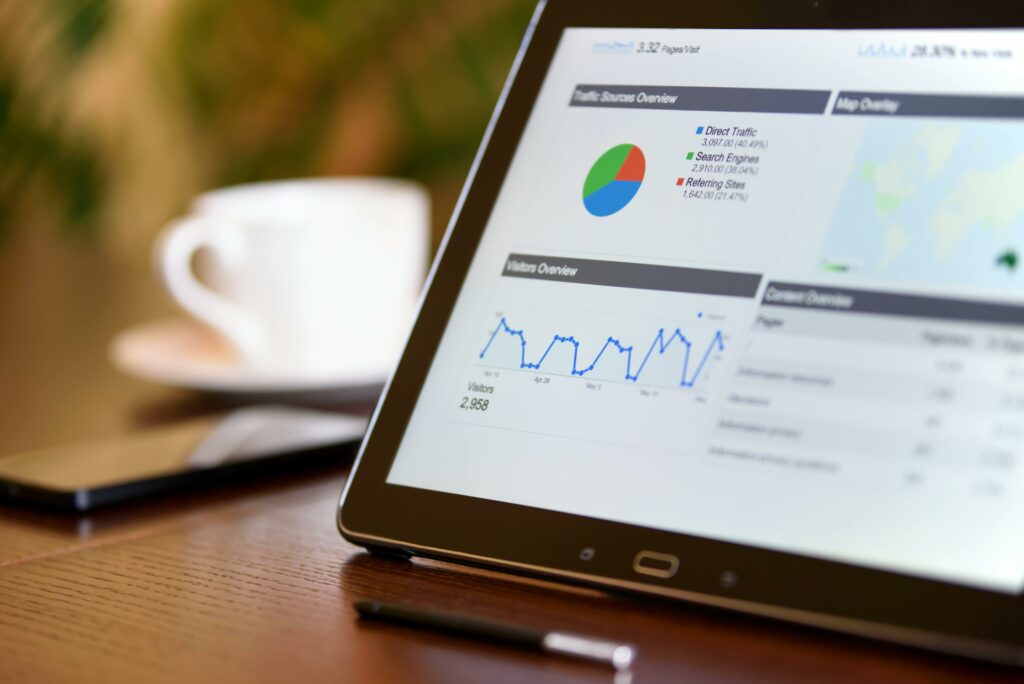
Introduction
Growing a business in today’s competitive landscape requires more than just a great idea—it demands a clear understanding of your market and the right digital strategies to turn opportunities into results. Whether you’re a small business or a large enterprise, the combination of market research and a tailored digital marketing plan can unlock new levels of success, helping you outpace competitors and achieve your goals.
But how do you ensure your efforts are both impactful and efficient? The secret lies in a data-driven approach. By mastering competitor analysis, leveraging tools like Google Analytics for performance tracking, and refining your campaigns through A/B testing and UX optimization, you can build a strategy that delivers measurable growth.
In this article, we’ll break down how market research and digital strategies work together to boost growth. From uncovering insights about your audience to launching full digital marketing campaigns, you’ll learn actionable steps to elevate your business. Let’s dive in!

Why Market Research is the Foundation of Growth
When it comes to boosting business growth, there’s no better starting point than market research. Think of it as the compass that guides your decisions, ensuring you’re heading in the right direction. Without a deep understanding of your market, competitors, and audience, even the most creative digital strategies can fall flat. Here’s why market research is the cornerstone of success:
1. Understanding Your Target Audience
To create campaigns that resonate, you need to know who you’re talking to. Market research helps you uncover key details about your audience—demographics, preferences, pain points, and behaviors. This knowledge allows you to craft personalized messages and offers that truly connect, driving engagement and conversions.
2. Analyzing Competitors to Identify Opportunities
Your competitors can teach you a lot. Through competitor analysis, you can identify what’s working (and what’s not) in your industry. Are there gaps in their offerings? Are they missing out on a specific audience segment? By answering these questions, you can position your business to fill those gaps and gain a competitive advantage.
3. Spotting Market Trends and Consumer Behavior
Markets are constantly evolving, and staying ahead means keeping a pulse on the latest trends. Market research helps you spot emerging patterns, whether it’s a shift in consumer preferences or a new technology disrupting your industry. Armed with this insight, you can adapt your strategies to stay relevant and ahead of the curve.
4. Reducing Risks and Making Informed Decisions
Launching a new product or campaign without research is like shooting in the dark. Market research provides the data you need to make informed decisions, minimizing risks and maximizing ROI. It ensures your resources are invested in strategies that align with real-world demand and opportunities.
5. Building a Strong Foundation for Digital Strategies
Once you’ve gathered insights from market research, you can create custom digital marketing plans that are tailored to your audience and goals. Whether it’s optimizing your website for better UX, running targeted ads, or crafting content that speaks directly to your customers, research ensures every effort is grounded in data.
The Bottom Line
Market research isn’t just a one-time task—it’s an ongoing process that keeps your business agile and responsive to change. By understanding your audience, analyzing competitors, and staying on top of trends, you lay the groundwork for sustainable growth. When combined with the right digital strategies, this foundation becomes a powerful engine for success.

Building a Data-Driven Digital Marketing Strategy
Once you’ve laid the groundwork with market research, the next step is to turn those insights into a data-driven digital marketing strategy. In today’s fast-paced digital world, guessing games won’t cut it—success hinges on using data to guide every decision. Here’s how to build a strategy that drives real results:
1. Set Clear Goals and KPIs
Every successful strategy starts with a clear destination. What do you want to achieve? Whether it’s increasing website traffic, boosting sales, or improving brand awareness, your goals should be SMART: Specific, Measurable, Achievable, Relevant, and Time-bound. Pair these goals with Key Performance Indicators (KPIs) like conversion rates, click-through rates, or customer acquisition costs to track progress effectively.
2. Choose the Right Digital Channels
Not all channels are created equal. Your market research should reveal where your audience spends their time—whether it’s on social media, search engines, or email. Focus your efforts on the platforms that align with your audience’s behavior and your business goals. For example:
- SEO and content marketing for long-term organic growth.
- PPC advertising for immediate visibility and leads.
- Social media marketing for engagement and brand building.
- Email marketing for nurturing relationships and driving repeat business.
3. Create Personalized, Audience-Centric Content
Data from your market research should inform every piece of content you create. Tailor your messaging to address your audience’s pain points, interests, and preferences. Whether it’s blog posts, videos, or social media ads, personalized content resonates more deeply and drives higher engagement.
4. Leverage Tools for Performance Tracking
To ensure your strategy is working, you need to measure its effectiveness. Tools like Google Analytics are essential for tracking metrics such as website traffic, bounce rates, and conversion rates. Use this data to identify what’s working and what’s not, so you can make real-time adjustments and optimize your campaigns.
5. Implement A/B Testing for Continuous Improvement
Even the best strategies can be improved. A/B testing allows you to experiment with different versions of your ads, emails, or landing pages to see what performs best. Test variables like headlines, visuals, or calls-to-action to refine your approach and maximize results.
6. Optimize for User Experience (UX)
A great strategy means nothing if your website or app frustrates users. Use insights from market research and performance tracking to improve your UX. Ensure your site is fast, mobile-friendly, and easy to navigate. A seamless experience keeps users engaged and more likely to convert.
7. Scale and Adapt Your Campaigns
As your strategy starts to deliver results, don’t be afraid to scale up. Allocate more budget to high-performing channels and campaigns. At the same time, stay flexible. Markets change, and so should your strategy. Regularly revisit your market research and performance data to adapt to new trends and opportunities.
The Bottom Line
A data-driven digital marketing strategy is the key to turning insights into action and achieving your business goals. By setting clear objectives, choosing the right channels, creating personalized content, and continuously optimizing based on data, you can build a strategy that delivers measurable growth.

Leveraging Competitor Insights for Competitive Advantage
In the race for business growth, understanding your competitors is just as important as understanding your own business. Competitor analysis is a powerful tool that helps you uncover what others in your industry are doing right—and where they’re falling short. By leveraging these insights, you can refine your strategies, identify opportunities, and gain a competitive edge. Here’s how to make the most of competitor insights:
1. Identify Your Key Competitors
Start by pinpointing who your competitors are. These could be direct competitors (businesses offering similar products or services) or indirect competitors (those targeting the same audience with different solutions). Use tools like SEMrush, Ahrefs, or Google Search to find businesses ranking for similar keywords or operating in your niche.
2. Analyze Their Strengths and Weaknesses
Once you’ve identified your competitors, dive deep into their strategies. Look at:
- Product Offerings: What are they selling, and how does it compare to yours?
- Pricing Strategies: Are they undercutting you, or are they positioned as a premium brand?
- Marketing Tactics: What channels are they using? Are they excelling in social media, SEO, or paid ads?
- Customer Feedback: What are their customers saying in reviews or on social media? This can reveal gaps in their offerings or areas where they excel.
By understanding their strengths, you can learn from their success. By identifying their weaknesses, you can find opportunities to differentiate yourself.
3. Study Their Digital Presence
Your competitors’ online presence is a goldmine of insights. Analyze their:
- Website: Is it user-friendly? What’s their content strategy? How are they optimizing for SEO?
- Social Media: Which platforms are they active on? What type of content gets the most engagement?
- Advertising: Are they running paid campaigns? What messaging are they using?
Tools like SimilarWeb or SpyFu can help you uncover their traffic sources, top-performing pages, and ad strategies.
4. Spot Gaps in the Market
One of the most valuable outcomes of competitor analysis is identifying gaps in the market. Are there underserved customer segments? Are there features or services your competitors aren’t offering? By filling these gaps, you can position your business as the go-to solution for unmet needs.
5. Benchmark Your Performance
Use competitor insights to benchmark your own performance. How does your website traffic compare to theirs? Are your social media engagement rates on par? Benchmarking helps you set realistic goals and identify areas where you need to improve.
6. Adapt and Innovate
The goal of competitor analysis isn’t to copy what others are doing—it’s to inspire innovation. Use the insights you gather to refine your digital marketing strategies, improve your products or services, and create unique value propositions that set you apart.
The Bottom Line
Competitor analysis is a critical component of any data-driven digital marketing strategy. By understanding what your competitors are doing—and where they’re falling short—you can make smarter decisions, seize opportunities, and gain a competitive advantage.

Measuring Success with Google Analytics and Performance Tracking
You’ve done the market research, built a data-driven digital marketing strategy, and analyzed your competitors—but how do you know if your efforts are paying off? That’s where Google Analytics and performance tracking come in. These tools are essential for measuring success, identifying what’s working, and optimizing your campaigns for better results. Here’s how to make the most of them:
1. Set Up Google Analytics for Your Website
The first step is to ensure Google Analytics is properly set up on your website. This powerful tool tracks user behavior, traffic sources, and conversions, giving you a clear picture of how visitors interact with your site. Make sure to:
- Define Goals: Set up specific goals, such as form submissions, purchases, or newsletter sign-ups, to track conversions.
- Enable E-commerce Tracking: If you run an online store, this feature helps you monitor sales performance.
- Link to Other Tools: Integrate Google Analytics with platforms like Google Ads and Search Console for a more comprehensive view.
2. Track Key Metrics
To measure success, focus on the metrics that matter most to your goals. Some of the most important metrics to track include:
- Traffic Sources: Where are your visitors coming from? (Organic search, social media, paid ads, etc.)
- Bounce Rate: Are visitors leaving your site without taking action?
- Conversion Rate: What percentage of visitors are completing your desired actions?
- Average Session Duration: How long are users staying on your site?
- Pageviews: Which pages are the most popular?
These metrics help you understand what’s driving results and where there’s room for improvement.
3. Use Attribution Modeling
Not all touchpoints in the customer journey are created equal. Attribution modeling helps you understand which channels and interactions are most influential in driving conversions. For example:
- First-Touch Attribution: Credits the first interaction a user had with your brand.
- Last-Touch Attribution: Credits the final interaction before a conversion.
- Multi-Touch Attribution: Spreads credit across all touchpoints in the customer journey.
By understanding the role of each touchpoint, you can allocate your budget more effectively and optimize your campaigns.
4. Monitor Campaign Performance
If you’re running paid ads, email campaigns, or social media promotions, tracking their performance is crucial. Use UTM parameters to tag your URLs and see which campaigns are driving the most traffic and conversions. This data helps you identify high-performing campaigns and refine underperforming ones.
5. Analyze User Behavior
Google Analytics provides insights into how users interact with your site. Use features like Behavior Flow and Site Content reports to:
- Identify which pages are most engaging.
- Spot where users are dropping off.
- Understand the paths users take to complete conversions.
This information is invaluable for improving user experience (UX) and optimizing your site for better results.
6. Create Custom Reports and Dashboards
To save time and focus on the metrics that matter most, create custom reports and dashboards in Google Analytics. Tailor these to your specific goals, whether it’s tracking e-commerce performance, monitoring blog traffic, or measuring lead generation.
7. Regularly Review and Optimize
Performance tracking isn’t a one-time task—it’s an ongoing process. Regularly review your data to identify trends, spot issues, and uncover opportunities. Use these insights to:
- Adjust your digital marketing strategies.
- Optimize underperforming campaigns.
- Double down on what’s working.
The Bottom Line
Google Analytics and performance tracking are essential tools for measuring the success of your marketing efforts. By tracking key metrics, analyzing user behavior, and using data to optimize your campaigns, you can ensure your strategies are delivering real results.

A/B Testing and UX Optimization for Better Results
Even the most well-crafted digital marketing strategies can benefit from fine-tuning. That’s where A/B testing and UX optimization come into play. These powerful techniques allow you to test different versions of your content, designs, and user experiences to see what resonates best with your audience. By continuously improving based on data, you can boost engagement, conversions, and overall performance. Here’s how to get started:
1. What is A/B Testing?
A/B testing (also known as split testing) involves comparing two versions of a webpage, email, ad, or other marketing asset to see which one performs better. For example, you might test:
- Different headlines or calls-to-action (CTAs).
- Varied visuals or color schemes.
- Alternate layouts or button placements.
The goal is to identify which version drives more clicks, conversions, or other desired actions.
2. How to Run Effective A/B Tests
To get the most out of A/B testing, follow these best practices:
- Test One Variable at a Time: Whether it’s a headline, image, or CTA, isolate one element to ensure clear results.
- Set Clear Goals: Define what success looks like—whether it’s higher click-through rates, more sign-ups, or increased sales.
- Use a Large Enough Sample Size: Ensure your test reaches a statistically significant audience to avoid skewed results.
- Run Tests Simultaneously: Test both versions at the same time to account for external factors like seasonality or market trends.
- Analyze Results and Implement Changes: Use tools like Google Optimize or Optimizely to track performance and apply the winning version.
3. The Role of UX Optimization
While A/B testing focuses on specific elements, UX optimization takes a broader approach to improving the overall user experience. A seamless, intuitive experience keeps users engaged and more likely to convert. Key areas to focus on include:
- Website Speed: Slow-loading pages frustrate users and increase bounce rates. Use tools like Google PageSpeed Insights to identify and fix performance issues.
- Mobile-Friendliness: With most users browsing on mobile devices, ensure your site is responsive and easy to navigate on smaller screens.
- Navigation: Simplify menus and make it easy for users to find what they’re looking for.
- Visual Design: Use clean, appealing designs that align with your brand and guide users toward desired actions.
4. Combining A/B Testing and UX Optimization
A/B testing and UX optimization work hand-in-hand to create a better experience for your audience. For example:
- Use A/B testing to determine the most effective CTA placement, then apply those insights to improve overall UX.
- Test different layouts to see which one reduces bounce rates and improves engagement.
- Experiment with personalized content to enhance user satisfaction and drive conversions.
5. Real-World Examples of A/B Testing and UX Optimization
- E-commerce: An online retailer tests two product page designs—one with a single “Buy Now” button and another with multiple CTAs. The winning design increases sales by 15%.
- SaaS: A software company tests different pricing page layouts and discovers that highlighting their most popular plan boosts sign-ups by 20%.
- Content Marketing: A blog tests two headline variations and finds that one drives 30% more clicks, leading to higher traffic and engagement.
6. Tools to Streamline the Process
Several tools can help you run A/B tests and optimize UX:
- Google Optimize: A free tool for creating and running A/B tests directly within Google Analytics.
- Hotjar: Provides heatmaps, session recordings, and user feedback to identify UX pain points.
- Crazy Egg: Offers heatmaps and A/B testing features to improve website performance.
- Unbounce: Ideal for testing and optimizing landing pages.
The Bottom Line
A/B testing and UX optimization are essential for refining your digital marketing strategies and delivering better results. By testing different variations and improving the overall user experience, you can boost engagement, increase conversions, and create a more satisfying journey for your audience.

Executing Full Digital Marketing Campaigns
Now that you’ve mastered market research, built a data-driven strategy, analyzed competitors, and fine-tuned your efforts with A/B testing and UX optimization, it’s time to bring it all together with full digital marketing campaigns. These campaigns are comprehensive, multi-channel efforts designed to achieve specific business goals, whether it’s driving sales, increasing brand awareness, or generating leads. Here’s how to execute them successfully:
1. Define Your Campaign Goals
Every successful campaign starts with a clear objective. What do you want to achieve? Common goals include:
- Increasing website traffic.
- Boosting sales or conversions.
- Growing your email list.
- Enhancing brand visibility.
Make sure your goals are SMART: Specific, Measurable, Achievable, Relevant, and Time-bound.
2. Identify Your Target Audience
Your market research should provide a clear picture of your ideal customer. Use this information to create detailed buyer personas, including demographics, interests, pain points, and behaviors. Tailor your campaign messaging and channels to resonate with this audience.
3. Choose the Right Channels
A full digital marketing campaign leverages multiple channels to reach your audience wherever they are. Common channels include:
- Search Engine Optimization (SEO): Drive organic traffic through optimized content and keywords.
- Pay-Per-Click Advertising (PPC): Use platforms like Google Ads or Facebook Ads for targeted, paid campaigns.
- Social Media Marketing: Engage your audience on platforms like Instagram, LinkedIn, or TikTok.
- Email Marketing: Nurture leads and keep your audience informed with personalized emails.
- Content Marketing: Create valuable content like blogs, videos, or infographics to attract and educate your audience.
4. Create Compelling Content and Creative Assets
Your campaign’s success hinges on the quality of your content. Develop assets that align with your goals and resonate with your audience, such as:
- Eye-catching visuals for social media and ads.
- Persuasive copy for emails and landing pages.
- Informative blog posts or videos to drive organic traffic.
Ensure all content is consistent with your brand voice and messaging.
5. Set a Budget and Allocate Resources
Determine how much you’re willing to spend on your campaign and allocate your budget across channels based on their potential ROI. For example:
- Invest more in high-performing channels like PPC or social media ads.
- Allocate resources to create high-quality content for SEO and content marketing.
Don’t forget to account for tools, software, and team resources needed to execute the campaign.
6. Launch and Monitor Your Campaign
Once everything is in place, it’s time to launch. But your work doesn’t stop there—continuous monitoring is key to success. Use tools like Google Analytics, social media insights, and email marketing reports to track performance in real-time. Key metrics to monitor include:
- Click-through rates (CTR).
- Conversion rates.
- Return on ad spend (ROAS).
- Engagement rates (likes, shares, comments).
7. Optimize Based on Data
As your campaign runs, use the data you collect to make adjustments. For example:
- Shift budget to high-performing channels or ads.
- Refine underperforming content or creatives.
- Test new variations through A/B testing to improve results.
This iterative approach ensures your campaign delivers the best possible outcomes.
8. Measure Results and Report
At the end of your campaign, analyze the results against your initial goals. Did you achieve what you set out to do? Create a comprehensive report that includes:
- Key metrics and KPIs.
- Insights gained from the campaign.
- Lessons learned for future campaigns.
Share this report with your team or stakeholders to demonstrate the campaign’s impact and inform future strategies.
The Bottom Line
Executing full digital marketing campaigns requires careful planning, execution, and optimization. By combining market research, data-driven strategies, and multi-channel efforts, you can create campaigns that drive real results and help your business grow.

Case Study: Real-World Example of Growth Through Market Research and Digital Strategies
To bring everything together, let’s look at a real-world example of how a business achieved significant growth by leveraging market research and digital strategies. This case study highlights the power of combining data-driven insights with well-executed campaigns.
The Challenge
A mid-sized e-commerce company specializing in eco-friendly home products was struggling to stand out in a crowded market. Despite having a great product line, their sales had plateaued, and their website traffic was declining. They needed a strategy to re-engage their audience, attract new customers, and boost sales.
The Solution
The company partnered with a digital marketing agency to develop a comprehensive growth plan. Here’s how they did it:
1. Conducting Market Research
The first step was to conduct in-depth market research to understand the target audience and competitive landscape. Key findings included:
- Audience Insights: Their core customers were environmentally conscious millennials who valued sustainability and transparency.
- Competitor Analysis: Competitors were excelling in social media engagement but lacked strong educational content about eco-friendly living.
- Trends: There was a growing demand for reusable and zero-waste products.
2. Building a Data-Driven Strategy
Using the insights from the research, the agency developed a custom digital marketing strategy focused on:
- Content Marketing: Creating blog posts, videos, and infographics about sustainable living and the benefits of eco-friendly products.
- Social Media Campaigns: Leveraging Instagram and Pinterest to showcase their products in real-life scenarios and share user-generated content.
- SEO Optimization: Targeting keywords like “eco-friendly home products” and “sustainable living tips” to drive organic traffic.
- Email Marketing: Sending personalized newsletters with product recommendations, eco-friendly tips, and exclusive discounts.
3. Executing Full Digital Marketing Campaigns
The agency launched a multi-channel campaign that included:
- Paid Ads: Running targeted Google Ads and Facebook Ads to reach eco-conscious shoppers.
- Influencer Partnerships: Collaborating with sustainability influencers to promote the brand.
- A/B Testing: Testing different ad creatives, email subject lines, and landing page designs to optimize performance.
- UX Optimization: Improving the website’s navigation, mobile responsiveness, and checkout process to enhance the user experience.
4. Measuring and Optimizing
Throughout the campaign, the agency used Google Analytics and other tools to track performance. Key metrics included:
- Website traffic and bounce rates.
- Conversion rates and average order value.
- Social media engagement and click-through rates.
Based on the data, they made adjustments like reallocating budget to high-performing channels, refining ad copy, and adding more educational content to the blog.
The Results
Within six months, the company saw remarkable growth:
- Website Traffic: Increased by 65%.
- Sales: Grew by 40%, with a significant boost in repeat customers.
- Social Media Followers: Doubled on Instagram and Pinterest.
- Email Subscribers: Increased by 50%, leading to higher engagement with email campaigns.
The campaign not only drove immediate results but also positioned the company as a trusted authority in the eco-friendly space, setting the stage for long-term growth.
Key Takeaways
This case study demonstrates the power of combining market research with data-driven digital strategies. By understanding their audience, analyzing competitors, and executing well-planned campaigns, the company was able to achieve measurable growth and stand out in a competitive market.
Final Thoughts
Whether you’re a small business or a large enterprise, the principles of market research, competitor analysis, performance tracking, and UX optimization can help you unlock new levels of success. By taking a strategic, data-driven approach, you can create campaigns that resonate with your audience, drive results, and fuel long-term growth.
GET IN TOUCH
Schedule a Consultation
Conclusion: Unlocking Growth with the Right Strategies
In today’s competitive digital landscape, business growth isn’t just about having a great product or service—it’s about understanding your market, leveraging data, and executing the right strategies. From market research and competitor analysis to data-driven digital marketing campaigns, every step plays a crucial role in driving success.
By combining these elements, businesses can:
- Understand Their Audience: Use market research to uncover customer needs, preferences, and behaviors.
- Outperform Competitors: Gain a competitive edge by identifying gaps and opportunities in the market.
- Optimize Campaigns: Use tools like Google Analytics, A/B testing, and UX optimization to refine strategies and maximize ROI.
- Execute Comprehensive Campaigns: Launch full digital marketing campaigns that integrate multiple channels for maximum impact.
The case study we explored is a testament to the power of this approach. By taking a strategic, data-driven path, the e-commerce company not only achieved immediate results but also built a foundation for sustainable growth.
Your Path to Growth Starts Here
Whether you’re a startup or an established business, the principles outlined in this article can help you unlock new opportunities and achieve your goals. Start by investing in market research, build a custom digital marketing strategy, and continuously optimize based on data.
Remember, growth doesn’t happen overnight—it’s the result of consistent effort, smart decisions, and a willingness to adapt. With the right strategies in place, you can turn challenges into opportunities and take your business to new heights.
Ready to Get Started?
If you’re looking to boost your business growth, now is the time to act. Use the insights and strategies shared in this article to create a plan that works for your unique needs. And if you need expert guidance, don’t hesitate to reach out to professionals who can help you navigate the complexities of digital marketing.
Here’s to your success—may your journey be data-driven, impactful, and full of growth!
Useful Resources
1. Market Research Tools and Guides
- Google Trends
https://trends.google.com
A free tool to explore trending topics and search behavior. - Statista
https://www.statista.com
A reliable source for market statistics and industry reports. - Pew Research Center
https://www.pewresearch.org
Offers insights into consumer behavior and demographic trends.
2. Competitor Analysis Tools
- SEMrush
https://www.semrush.com
A comprehensive tool for competitor analysis, SEO, and PPC research. - Ahrefs
https://ahrefs.com
A popular tool for backlink analysis, keyword research, and competitor insights. - SimilarWeb
https://www.similarweb.com
Provides traffic and engagement data for competitor websites.
3. Google Analytics and Performance Tracking
- Google Analytics Help Center
https://support.google.com/analytics
Official guides and tutorials for setting up and using Google Analytics. - Google Search Console
https://search.google.com/search-console
A free tool to monitor and optimize website performance in search results. - Hotjar
https://www.hotjar.com
Offers heatmaps, session recordings, and user feedback for UX optimization.
4. A/B Testing and UX Optimization
- Google Optimize
https://optimize.google.com
A free tool for running A/B tests and personalizing website experiences. - Optimizely
https://www.optimizely.com
A leading platform for experimentation and optimization. - Crazy Egg
https://www.crazyegg.com
Provides heatmaps and A/B testing tools to improve website performance.
5. Digital Marketing Campaigns
- HubSpot Marketing Blog
https://blog.hubspot.com/marketing
Offers tips and strategies for running successful digital marketing campaigns. - Neil Patel’s Blog
https://neilpatel.com/blog
A trusted resource for SEO, content marketing, and digital strategy insights. - Moz Beginner’s Guide to SEO
https://moz.com/beginners-guide-to-seo
A comprehensive guide to understanding and implementing SEO.
6. Case Studies and Success Stories
- Think with Google
https://www.thinkwithgoogle.com
Features case studies and insights from successful digital marketing campaigns. - Social Media Examiner
https://www.socialmediaexaminer.com
Provides real-world examples of social media marketing success. - Content Marketing Institute
https://contentmarketinginstitute.com
Offers case studies and resources for effective content marketing.
7. Additional Resources
- Canva
https://www.canva.com
A free design tool for creating visuals for digital campaigns. - Mailchimp Email Marketing Guide
https://mailchimp.com/resources/email-marketing-guide
A beginner-friendly guide to email marketing best practices. - Unbounce Landing Page Builder
https://unbounce.com
A tool for creating and optimizing high-converting landing pages.


